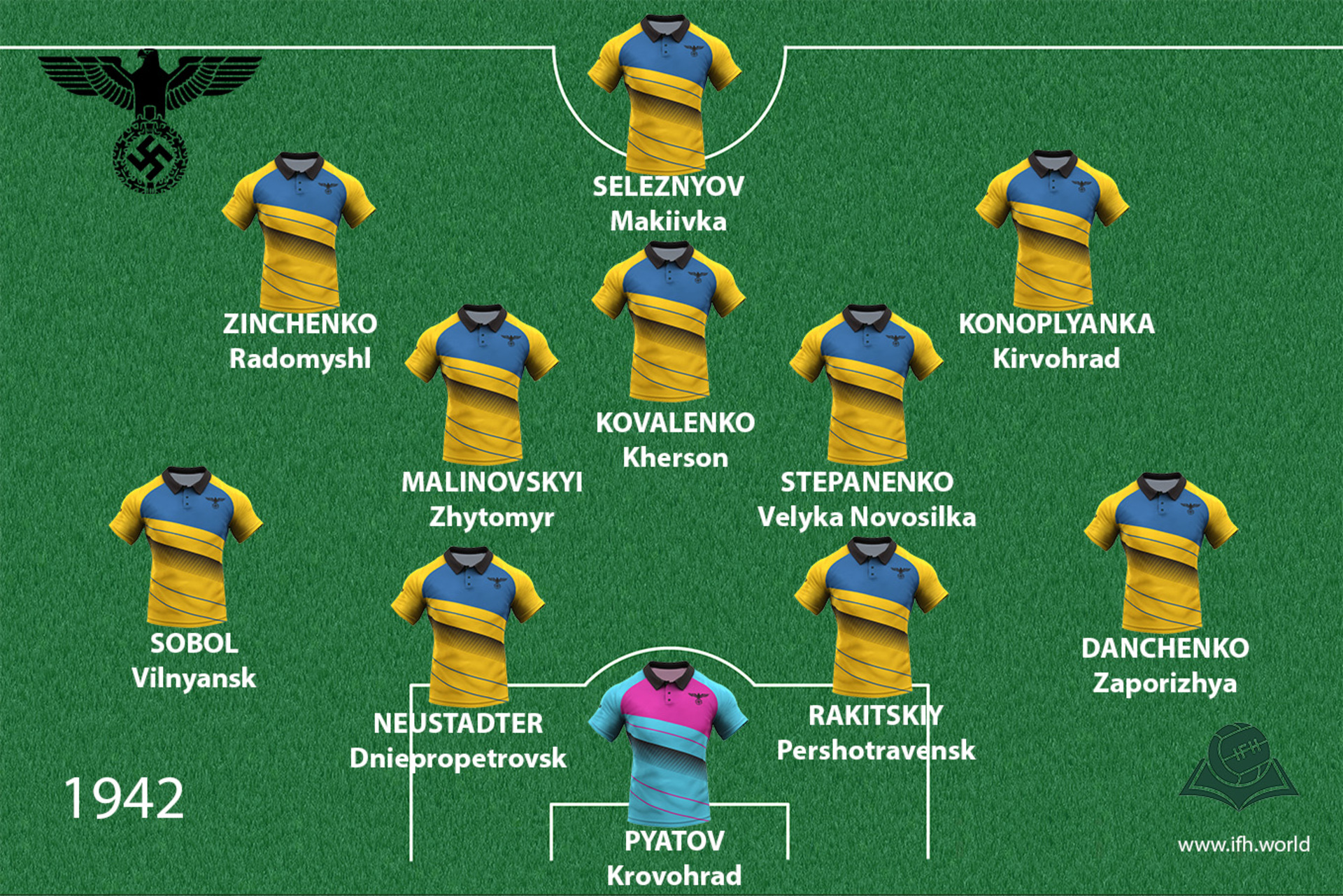Reichskommissariat Ukraine
Reichskommissariat Ukraine (RKU) was the civilian regime of Nazi Germany on the occupied parts of pre-war Soviet-Ukraine and Polish Republic. Since the Nazis had their own plans for Ukraine, the OUN became important in the development of a national history of Ukraine because it constituted the closest approximation to a national army on one hand, and through its consistent advocacy of an independent Ukraine on the other.

Coat of arms
Shirt
| Position | First name | Last name | Mjesto rođenja | Like | Dislike |
|---|
(Today: central Ukraine)
Initially, the Germans were greeted as liberators by some of the Ukrainian populace. There had long been a widespread belief that Germany, as the avowed enemy of Poland and the USSR, was the Ukrainians’ natural ally for the attainment of their independence. The illusion was quickly shattered. Soon after the Operation Barbarossa, the OUN-B declared an independent Ukrainian state on 30 June 1941 in occupied Lviv, while the region was under the control of Nazi Germany. In response, the Nazi authorities suppressed the OUN leadership. Far from supporting Ukrainian political aspirations, the Nazis soon attached Galicia administratively to Poland, returned Bukovina to Romania, and gave Romania control over Transnistira with its capital at Odessa. The remainder was organized as the Reichskommissariat Ukraine. Under such conditions in 1942 the OUN-B established the The Ukrainian Insurgent Army (UPA) which was engaged in guerilla warfare against Nazi Germany, Soviet partisan movement and various Polish factions. Its ultimate purpose was an independent and unified Ukrainian state. [1]
Organization of Ukrainian Nationalists (OUN), founded in 1929 in the territories of Ukraine that were included in Poland after the First World War. In 1940, and following the 1938 assassination of its original leader Yevhen Konovalets’, the OUN split into two bitterly opposed factions: OUN-M and more radical OUN-B. The radicalization of Ukrainian nationalism in the interwar period was preceded by a number of causes: the defeat of the Ukrainian Revolution in 1917-21, Polish authorities' actions against the Ukrainian minority in Poland, Soviet oppression, imprisonment and killing of politically unit Ukrainians, the Soviet agrarian policy which caused the deaths of millions of Ukrainians from hunger. Although it is similar in some views, the ideology of the OUN can not be identified with Nazism or Fascism. Rather it is a product of domestic opportunities, not of external influence. It is characterized by the belief that nation is the highest value, charismatic leader, antiparliamentarianism, anti-communism, anti-Semitism with strong stereotypical identification of Jews with Bolsheviks, hatred of Poles, Russians, Moscow, etc. Like all other European national ideologists and politicians, Ukrainians also claimed that Ukrainian nationalism and nation had been thousands of years old.[2]
However, the Germans did not take advantage of these elements. Instead, they established Reichskommissariat Ukraine which was originally subject to Alfred Rosenberg's Reich Ministry of the Occupied Eastern Territories. In their racist theories they saw Ukraine as Lebensraum for the German people. The reichcommissars were treating Ukrainians as ‘‘white Negroes’’ because, as they asserted, the ‘‘territory will be built up like a colony.’[3]
Nevertheless, the Nazis disagreed on the issues of future plans for Ukraine. Rosenberg respected the Ukrainian desire for independence by referring to the Viking history and the founding of the medieval state of the Kievan Rus when Kiev was the center of the state with the Nordic ruling class. On the other side, Hitler did not want any autonomous state with military force west of Urals - which for the sake of Germany's security, for the achievement of Lebensraum and the rooted view of the Slavs as lower race. He also understood the importance of her fertile plains as a food supply for Germany. [4
- [1] ''Ukraine. The Nazi occupation of Soviet Ukraine'', https://www.britannica.com/place/Ukraine/The-Nazi-occupation-of-Soviet-Ukraine#ref404619
- [2] David R. Marples, Heroes and Villains: Creating National History in Contemporary Ukraine, CEU Press, Budapest, New York 2007., 79, 284, 285, 286
- [3] Wendy Lower, Nazi Empire-Building and the Holocaust in Ukraine, The University of North Carolina Press, 2005109
- [4] ''Ukraine in German Strategic Plans''http://litopys.org.ua/ukrxx/e13.htm
Sources
- Wendy Lower, Nazi Empire-Building and the Holocaust in Ukraine, The University of North Carolina Press 2005
- David R. Marples, Heroes and Villains: Creating National History in Contemporary Ukraine, CEU Press, Budapest, New York 2007
- ''Ukraine. The Nazi occupation of Soviet Ukraine'', https://www.britannica.com/place/Ukraine/The-Nazi-occupation-of-Soviet-Ukraine#ref404619
- ''Ukraine in German Strategic Plans''http://litopys.org.ua/ukrxx/e13.htm
